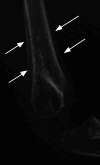Radiographs in Pediatric Rheumatology: Where Do We Stand?
- PMID: 39697497
- PMCID: PMC11651862
- DOI: 10.1055/s-0044-1789232
Radiographs in Pediatric Rheumatology: Where Do We Stand?
Abstract
Rheumatic disorders in children include inflammatory arthritis, inflammatory bone disorders such as chronic nonbacterial osteomyelitis (CNO), connective tissue disorders, and vasculitides (juvenile dermatomyositis, scleroderma). The diagnosis in these children is based on a combination of history, clinical examination, and laboratory investigations. Radiographs play an important role in children with arthritis, who have atypical presentation or for assessment of disease-related damage and differentiation from mimics. Further, radiographs also have an ancillary role in the assessment of musculoskeletal disorders such as dermatomyositis and hemophilia. This review seeks to present a detailed analysis of the specific indications and advantages of radiographs in the situations. Further, a structured reporting format for assessment of radiographs in pediatric rheumatic disorders has also been presented for the reader's reference.
Keywords: X-rays; chronic nonbacterial osteomyelitis; juvenile idiopathic arthritis; pediatrics; rheumatology.
Indian Radiological Association. This is an open access article published by Thieme under the terms of the Creative Commons Attribution-NonDerivative-NonCommercial License, permitting copying and reproduction so long as the original work is given appropriate credit. Contents may not be used for commercial purposes, or adapted, remixed, transformed or built upon. ( https://creativecommons.org/licenses/by-nc-nd/4.0/ ).
Conflict of interest statement
Conflict of Interest None declared.
Figures














References
-
- Sheybani E F, Khanna G, White A J, Demertzis J L. Imaging of juvenile idiopathic arthritis: a multimodality approach. Radiographics. 2013;33(05):1253–1273. - PubMed
-
- International League of Associations for Rheumatology . Petty R E, Southwood T R, Manners P et al.International League of Associations for Rheumatology classification of juvenile idiopathic arthritis: second revision, Edmonton, 2001. J Rheumatol. 2004;31(02):390–392. - PubMed
-
- Ravelli A, Martini A. Juvenile idiopathic arthritis. Lancet. 2007;369(9563):767–778. - PubMed
-
- Arkun R, Mete B D. Musculoskeletal brucellosis. Semin Musculoskelet Radiol. 2011;15(05):470–479. - PubMed
-
- Felici E, Novarini C, Magni-Manzoni S et al.Course of joint disease in patients with antinuclear antibody-positive juvenile idiopathic arthritis. J Rheumatol. 2005;32(09):1805–1810. - PubMed
LinkOut - more resources
Full Text Sources

